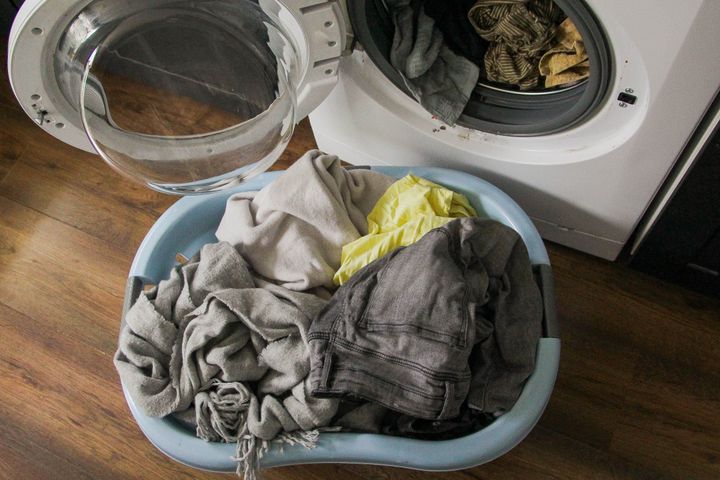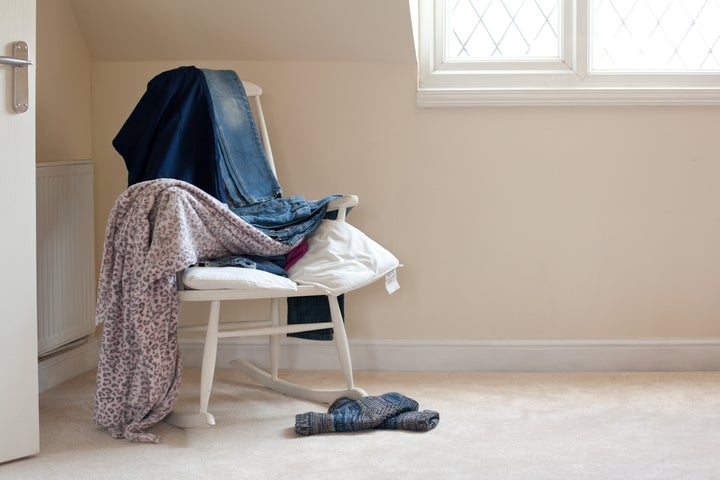
Do you ever delay putting away clean laundry or unworn outfits from a vacation and instead keep those clothes in a pile on the floor or draped over a chair for many days on end? What about items you’ve only worn once and don’t want to wash but also don’t want to return to your closet because you think you’ll wear them again in the near future?
If that sounds familiar, you might have what some call a “floordrobe.” And this manifestation of laundry clutter is quite common among people with ADHD.
On April 12, ADHD coach Jeff Rice broke down the phrase in a TikTok video that has been watched almost 5 million times.
“A ‘floordrobe’ is a place, typically on the floor, where we leave either clean or ‘not quite dirty’ clothes,” he said. “It can be in a laundry basket that just sits there for days and days or weeks, or it can be in a pile of clothes that you’ve worn for a little while, but they didn’t quite get dirty. And so you think you’re going to wear them again, and so you leave them sitting on the floor or hanging over a chair or whatever.”
He also offered a few ideas to help people with ADHD tackle this type of clutter. But why exactly are laundry issues like floordrobes so common in people with the disorder? We asked ADHD experts to explain the phenomenon and share their advice for keeping clothes from piling up into an overwhelming mess.
What’s the connection between floordrobes and ADHD?
“ADHD impacts the brain’s executive functions, which control motivation, planning, working memory, organization and self-control,” said Billy Roberts, a therapist at Focused Mind ADHD Counseling in Columbus, Ohio. “When faced with a task that is boring, the ADHD brain gets overwhelmed and starts craving more interesting tasks. Tedious chores like laundry tend to be particularly frustrating because they can pile up, leading many with ADHD to feel incredibly overwhelmed and to further avoid the task.”
In addition to being uninteresting, laundry is not typically an urgent matter (at least not until you’re out of clean underwear).
“When you have a brain that is easily distracted by competing inputs, it’s hard for a task that is both boring and often non-urgent to get prioritized, whereas urgent tasks have a way of breaking through other distractions, essentially ‘insisting’ that they get done,” said therapist Rachael Bloom, who practices in Los Angeles.
She pointed to research that suggests individuals with ADHD have fewer beta brainwaves.
“These are the type of brain waves that keep us mentally alert and focused,” Bloom said. “Stress — being in crisis or even being under a deadline — can produce extra beta waves, which might actually help ‘turn on’ focus in individuals with ADHD.”
In addition to the executive function aspect, laundry also involves short-term memory, which can be another challenging area for people with ADHD.
“That’s why many people really struggle with remembering to move the clothes from the washer to the dryer, which then adds to the misery of having to start all over in order to avoid the awful mildew smell that hits us when we finally remember to get to the washing machine,” said Michigan-based psychotherapist and ADHD coach Terry Matlen.
Matlen emphasized that the seemingly endless nature of laundry adds to the challenge.
“As hard as it is to do, we know that it’s going to start all over the following day,” she said. “The mounds of clean and dirty laundry replicate themselves every few days or so.”
Another issue, which Rice touches on in his video, is that many people with ADHD tend to experience “time blindness.”
“This makes it difficult to accurately estimate how long a task will take, even if it’s a task you’ve performed countless times before,” Bloom said.
When you lack a strong internal sense of time, you might feel that putting away your clothes will take an overwhelmingly long amount of time and thus avoid the chore.

How should you deal with your floordrobe?
In his video, Rice offered a couple of suggestions for dealing with floordrobes, most notably one that addressed the lack of time awareness issue.
“Whenever I look at a basket of laundry, I think, ‘Oh my gosh, this is going to take forever to put away,’” he said. “And objectively, it’s not true. One of the ways that I attacked this was, at one point, I had three baskets of laundry sitting in my closet and I didn’t want to put them away. So I decided to check to see how long does it really take for me to put away three baskets of laundry. The answer — 21 minutes. I set a timer, and I timed myself while I put them away ― seven minutes per basket.”
Having the hard data about the amount of time required for a chore “helps control the emotional part” of his ADHD brain that builds up the process into something bigger than it is, he explained. Thus, the intellectual side of his brain can take over and allow him to deal with the mundane task.
Bloom emphasized the importance of starting with small changes and experimenting to find the best strategy for your personality and lifestyle.
“It’s easy to feel overwhelmed by all of the things that can feel harder due to ADHD, and I work a lot with my clients around acceptance so that they feel less defeated and more motivated to tackle the things that are most important to them,” she said. “That might mean deciding it’s OK if clean laundry never gets put away on time, as long as the clothes get washed. It’s also a lot of trial and error, because what works for one person might fail miserably for someone else.”
For example, paring your clothes down to a simple capsule wardrobe might be the perfect answer for someone who would like to have fewer clothes to wash and therefore shorten the task of laundry. But someone else may feel too constricted by having such limited options for what to wear every day.
“Similarly, someone might benefit from what’s called ‘chunking,’ or splitting a larger task up into smaller, more manageable steps and doing a little bit each day,” Bloom said. “Someone else might prefer to schedule an hour block each week for laundry and pair it with a favorite podcast or TV show — this is called ‘pairing.’ Each strategy is great, but they are totally different.”
Roberts recommended trying ADHD productivity hacks that increase accountability.
“An example of this would be body doubling — having someone sit with you while you get started,” he said. “Another strategy to make a task that is boring less boring is ... to make it less boring. Look for ways to increase novelty — making a game out of it, listening to new music while you do it — or find ways to increase immediate rewards once a task is complete.”
You might allow yourself to binge one or two episodes of your new favorite TV show after tackling the laundry clutter, for instance.
“If you have enough space, buy extras so that you don’t have to do laundry as often,” Matlen said. “For example, buy two weeks’ worth of underwear and socks. Buy the same color and same brand of socks so that they’re easily paired with a mate.”
If your floordrobe gets out of control, consider if there are bigger emotional roadblocks at play.
“Anxiety and perfectionism can create an avoidance of mess, or task aversion paired with hopelessness can be a sign of depression,” Roberts said. “Since ADHD can co-occur with many other mental health concerns, it can be helpful to monitor if this is a ‘typical floordrobe’ or if it’s starting to feel like an ‘epic floordrobe,’ which might mean some additional mental health support is needed.”
Whatever your situation, try to be kind to yourself and do your best to remove any feelings of shame. If you want to make changes, understand that shifting habits can take time, so resist the urge to give up too quickly.
And remember that you don’t necessarily have to make any changes.
“Check in with yourself,” Bloom said. “Do you care if you have a floordrobe? If it doesn’t bother you, feel free to move on.”
For lots more laundry trips and tricks, listen to our “secrets of doing laundry” episode of HuffPost’s “Am I Doing It Wrong?” podcast featuring laundry expert Patric Richardson.